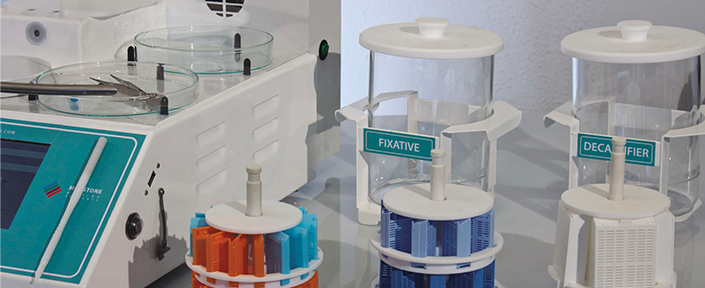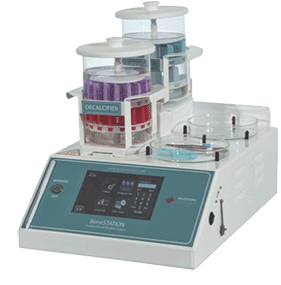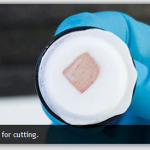Standardization of decalcification for optimum molecular testing
Products are for professional/laboratory use only.
Molecular diagnostics are rapidly becoming part of the standard of care for cancer patients. This biomarker based approach serves to select patients likely to benefit from targeted treatment regimens and potentially assists in their inclusion into appropriate clinical trials.
Bone is a common and occasionally the sole site of metastasis or sampling. Bone biopsies, however, present an unique challenge to molecular diagnostics, as they are subject to decalcification during routine histology processing. As the major structural and supportive connective tissue, bone is hard and rigid. Inclusion of minerals in its osteoid matrix give it both strength and rigidity. Three major components make up bone tissue: minerals or crystalline component (70%), organic extra cellular matrix or flexible collagen (30%) and cells in the marrow. The crystalline component of bone is composed mainly of calcium which interferes with normal histologic process and prevents the normal sectioning of blocks. The aim of decalcification is to remove inorganic calcium from calcified tissues, and make bone flexible and easy to cut for pathological evaluation.
Unfortunately, commonly used decalcification agents containing strong acids (i.e. HCL, Nitric acid) result in degradation of nucleic acid required for subsequent molecular profiling and biomarker analysis. The ideal decalcifying agent removes calcium from tissues without producing destruction and detrimental to subsequent analysis, such as chelating agents. They bind calcium slowly and gently by forming an insoluble non-ionized complex, so it is the preferred method in case of need of subsequent analysis like electron microscopy, immunohistochemistry and molecular biology. EDTA (Ethylendiaminetetraacetic acid) is the most common chelating agent. The rate at which EDTA will decalcify is pH dependent. The optimal pH is 7.0-7.4.
Because the chelating process is very slow, this reagent is not suitable for urgent large and hard specimens but more appropriate for bone marrow and soft little bones, where very high quality morphology is required or particular molecular elements must be preserved for techniques such as IHC, FISH or PCR.
By using an infrared contactless sensor controlled heating system, Milestone’s BoneSTATION accelerates the decalcification reaction under standardized conditions. A magnetic stirrer ensures homogeneity of temperature throughout the solution as well as the presence of “fresh” reagent on the surface of the bone.
Milestone’s MOLDecal is an innovative decalcifying agent for optimized molecular results. It consists of a proprietary mixture of EDTA salts to obtain an ideal decalcification pH of 7.2-7.4, with no addition of buffer. When combined with the BoneSTATION’s agitation and temperature control, MOLDecal can reduce the decalcification time while maintaining a high recovery level for nucleic acids.
This is part four in the blog post series: Milestone’s chain of custody
Previous posts:
Safe specimen transfer from the theatre to the lab >
Standardization in specimen description at the grossing station >
Optimization and documentation of the fixation step >








